Explore New Creative Horizons in Pottery with French Master Matthieu Liévois
Get inspired by creative shapes to replicate, and learn how to develop your own shapes using technical drawings

1 hour of video to learn how to create your own technical drawing
Learn techniques to sketch pottery shapes accurately before throwing
57 technical drawings to guide your throwing
Identify potential difficulties, such as joint placement or trimming needs
Learn to replicate precise shapes for series production
Access to a community to deepen your knowledge and ask questions

Technical drawing course
$50
1-hour class to learn how to create your own technical drawing.
Technical drawings to download and throw on the wheel: 57 creative shapes.
"It is wonderfully well explained, with great kindness and professionalism. The attention to detail in the techniques is really impressive, I am really delighted. Thank you for sharing your expertise. With all my gratitude."

Helene
Online Student
$50
Have you ever been so disappointed with the results that you were discouraged from exploring unknown, inventive, bold shapes…
…leading you to abandon your good ideas?

Take control of your creativity…
…and dare to follow your ideas.
A new idea only becomes good if it’s allowed to flourish in a safe environment, without the risk of disappointment.
How can you explore a new idea without getting discouraged?
The solution is very simple, and it’s what all designers
and architects already do without exception:
You need to draw the shape before throwing,
using a technical drawing...
…to clarify your idea before putting it into practice.
What is a technical drawing?
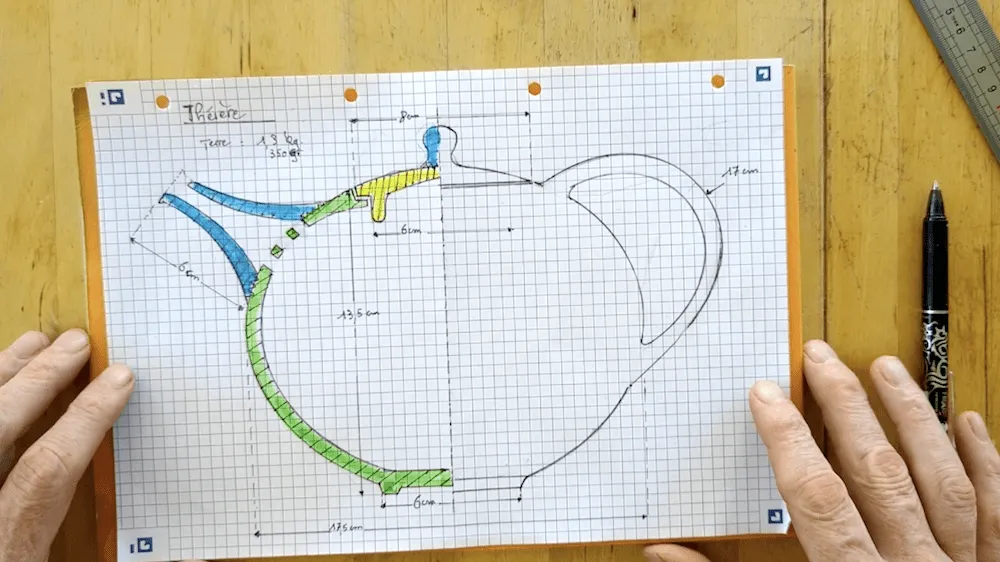
It is a profile drawing of a shape to be thrown, with one half shown in cross-section and the other half as an exterior view.
The cross-section determines:
the thicknesses for throwing,
the places where the piece will be trimmed (like a foot that will be hollowed out),
and the places where additional elements will be added (like a teapot spout, a handle, or a lid knob).
Following precise codes (type and thickness of lines) respected across all industries, it is done to real scale when possible, to give an exact preview of the result, and to make the drawing easier to follow.
Why should you get it?
1 - Boost your creativity with 57 drawings of unique and original shapes, created for by Matthieu for this course
2 - Learn to anticipate the difficulties of throwing, as it forces you to think through all the steps of throwing and trimming in advance
3 - Follow Matthieu’s detailed explanations on creating a technical drawing, with the example of a teapot, to learn to make your own drawing, your own shapes
With this course, you'll receive ...
1 course on creating technical drawings
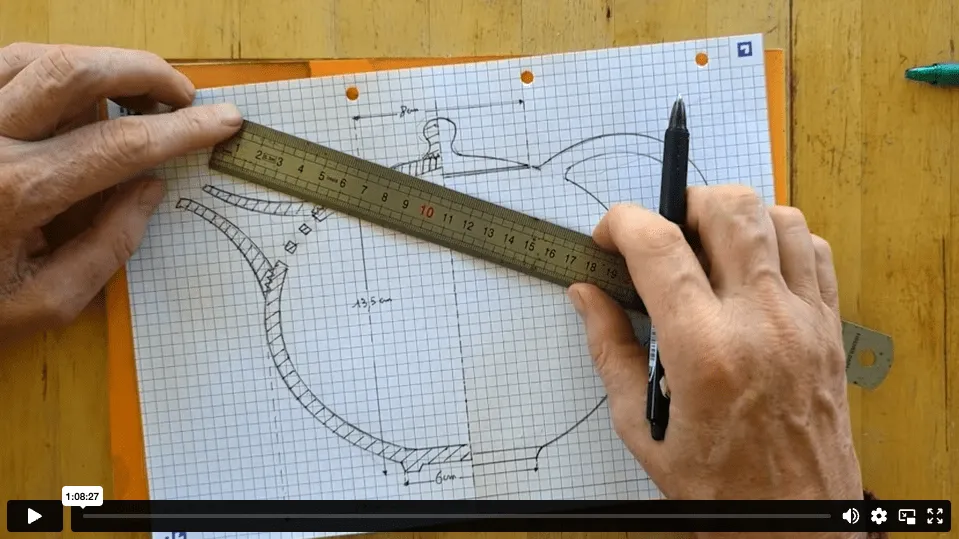
57 original technical drawings to download
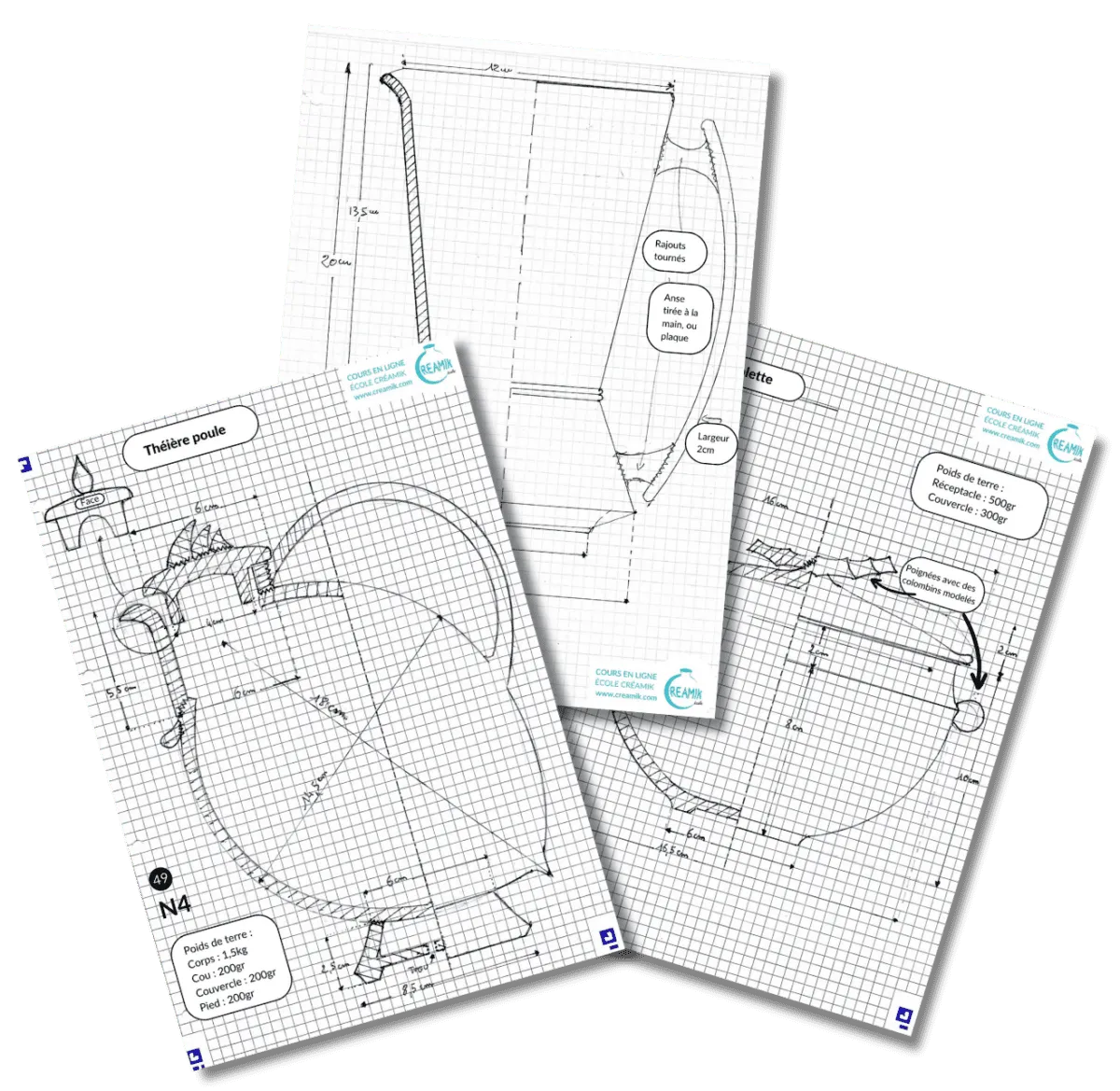
Access to a community to deepen your knowledge and ask questions
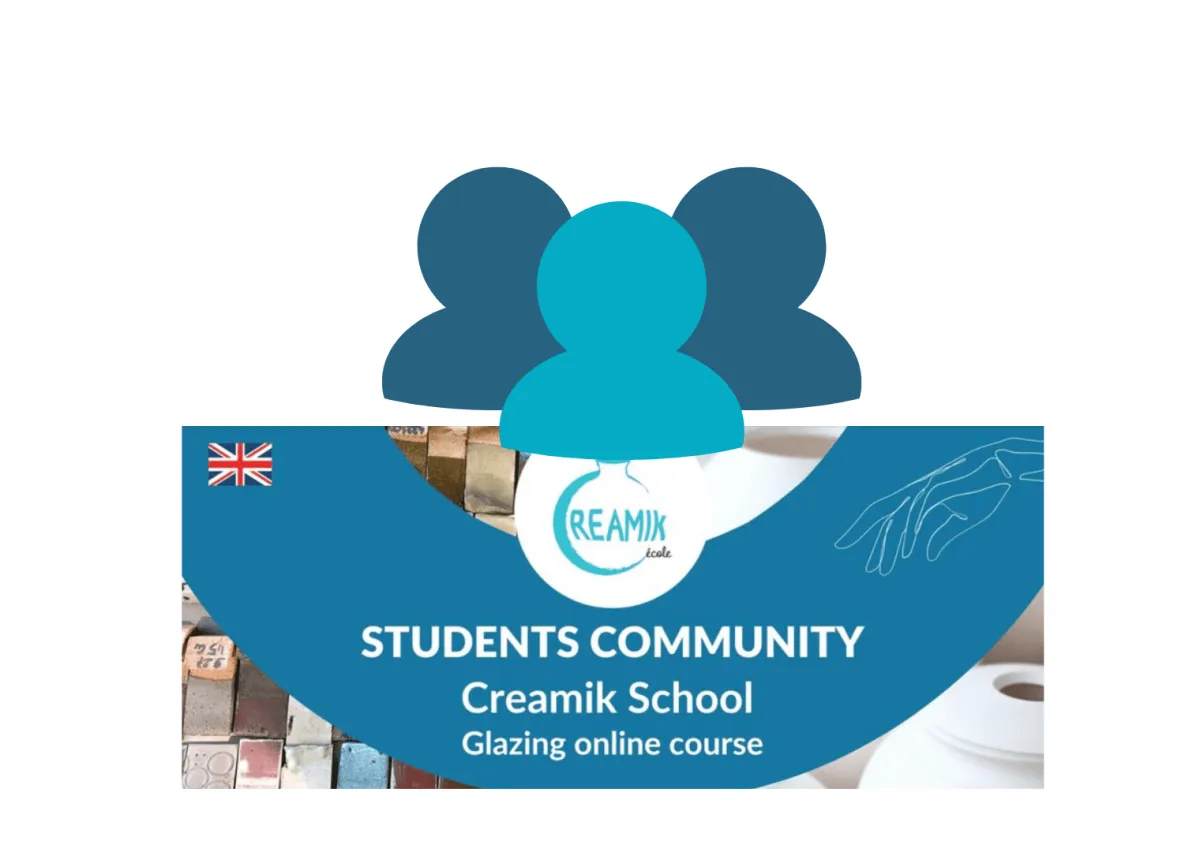
What are the benefits of a technical drawing ?

1- Test your idea
Visualize how to create the pottery (especially less obvious parts like male and female mortises for joints). Anticipate the difficulties of throwing, as it forces you to think through all the steps of throwing and trimming in advance.
2- Create series
When you learn to follow a technical drawing in pottery, you learn to adhere to precise shapes and dimensions decided in advance. This consistency then allows you to throw several identical pieces and create series.
3- Fulfill orders
When you create pottery for someone else, communication between you and the person is key. Being able to communicate using a technical drawing allows you to agree, avoid disappointments, and save time!

Still unsure ?
Think you have no drawing talent?
No problem! A technical drawing is very different from an artistic drawing. As long as you can hold a pencil, you can do it! You might even surprise yourself…
Don’t like the rigidity?
The technical drawing is there to make your wildest ideas possible by making them technically feasible! And once everything is clear in your mind thanks to it, nothing forces you to follow it exactly…
No ideas to explore?
Ideas come from creating! Start by learning to draw, and by following the 57 technical drawings in pottery. This will fuel your creativity to find your own ideas!
4,100 students and growing
Our students’ experiences are at the heart of everything we do. Their words reflect the passion, growth, and creativity they’ve found in our course.
"Thanks to the defects map, i was able to quickly identify avenues to explore in solving my problems. I sincerely believe I saved several months of research! This document is very well-structured and perfectly understandable. Many thanks!!"
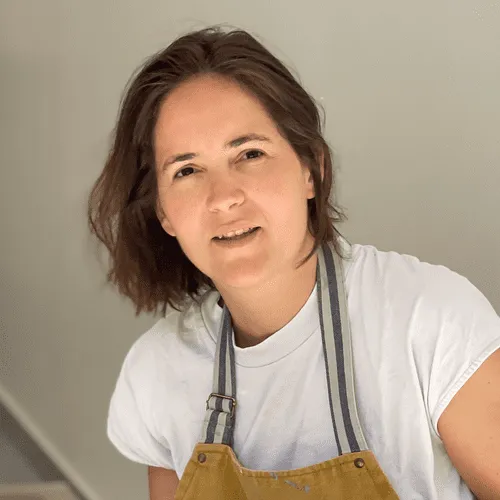
Solene
Online Student
"Unforgettable experience! Matthieu's teaching is very benevolent, no constraint, only pleasure, which facilitates things. I acquired good bases to found my workshop, then it is necessary to continue to work, to work and to work. Thank you to the whole team and keep up the good work!"
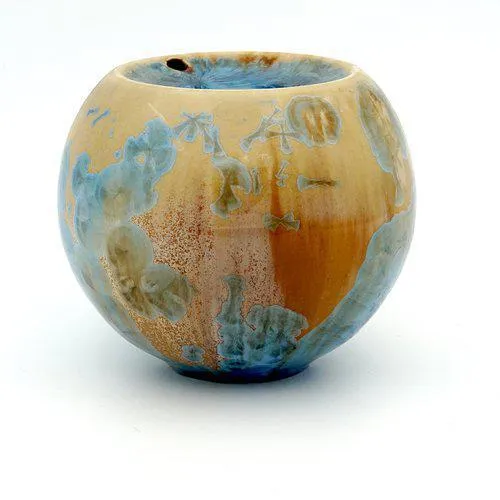
Delphine
Online Student
"The instruction offered is of exceptional quality. The course, which is specific and concrete, is extremely well presented in an affective way: a sentence, a piece of information. The illustrations accompany the presentation perfectly."

Rose-Marie
Online Student
"Matthieu's online courses are a gold mine for anyone who wants to start creating glazes or, like me, get a refresher (3 years after my professional training)."
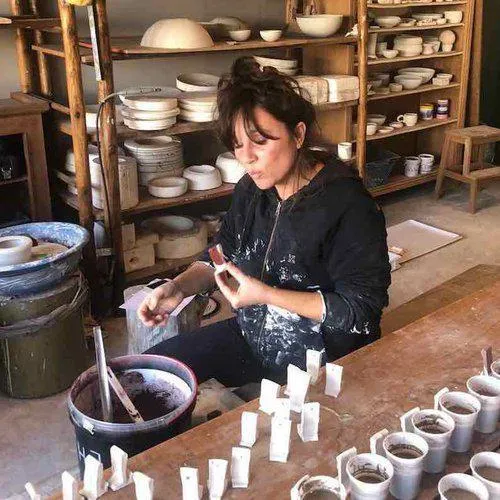
Anne-Laure
Online Student
"It's wonderfully well explained, with a lot of kindness and professionalism. The attention to detail in the techniques is really impressive, I'm truly delighted. Thank you for sharing your expertise. With all my gratitude."

Helene
Online Student
"Great online courses. The attention to detail of the techniques, really I am delighted. THANKS."

Hélène
Student
Frequently Asked Questions
What does lifetime access means?
This means that the course you buy is yours: you can log in to the member area of the website and watch the videos as often and for as long as you want, without ever having to pay any additional fees.
(We also strongly recommend that you watch the videos several times to fully immerse yourself in the content!)
Any additions or improvements to the course in the future are also included in your purchase: you will have access to them without having to pay anything more.
Do I need to have basic knowledge to take this course?
No. No prior knowledge is required to take this course.
Why buying the basic course and the advanced course at the same time when you are a beginne ?
The basics course will teach you how to mix glaze powders and how to fire your glazed ceramics.
The advanced course covers, among other things, the influence of clay on glaze, the different types of kilns and the choices you have when buying one. It demonstrates all the techniques for applying glaze to pottery: with a brush, dipping, or using a spray gun. These are important things to consider when purchasing your clay and equipment and are very helpful to know when you are starting out.
The parts of the advanced course that deal with the layering of glazes and crystallization also open up interesting perspectives for you from the start.
Math is not my forte: is this course for me?
You don’t need any prior knowledge of math or chemistry. We offer video reminders that cover everything from A to Z: what is a fraction, a percentage, a cross product in math, a chemical formula, orders of magnitude and even molecular weights in chemistry.
You just have to be willing to learn and let go of that old image of yourself or your high school math classes. The lack of a concrete goal is often the reason someone becomes allergic to math, and today, you have a very good reason to learn it.
You should also know that though we consider it very important to do your first calculations of glazes by hand, so that you understand in depth the steps of creating a recipe, you will not have to calculate each of your glazes for the rest of your life: there is good software for this, and we will show you how to use it.
Why can't defects be avoided even with pre-made glaze?
These glazes are designed by manufacturers to avoid defects. If all goes well, there shouldn’t be any.
But the manufacturer tested their glaze on a specific clay, and the clay has a huge influence on the glaze (as does the kiln, the laying of the glaze, and many other parameters). The manufacturer cannot foresee the variations of all these factors.
If your ceramics come out of the kiln with defects, you can try these adjustments:
=> If the glaze has pimples, you have fired at too low a temperature; fire the next kiln a few degrees higher.
=> If the glaze became runny, you fired too high; fire lower next time.
=> But what if you still have one or the other? What if the clay has influenced the colour, and you’re not getting the hue you were hoping for?
In this case, you will not be able to do anything, because you do not know the composition of the glaze. You will not be able to modify it to solve the problem.
Hence the convenience of making your own glazes: you will be able to control all your parameters and will always be able to rectify the situation when a defect appears.
Is it really possible to create your own glazes after only taking this online course?
Yes! Including (more complex) crystallization glazes, if these interest you. Many students have already demonstrated that it is possible!
Of course, like any new skill we learn, it requires commitment, some rigour and training. There will be failures, moments of discouragement and eureka moments. The same goes for wheel-throwing!
What equipment do I need (and how much will it cost)?
To do what is explained in the course, you need at least:
– A precision scale for 100g (10€)
– A precision scale for 10kg (80€)
– Small equipment (whisk, sieve, ladle, cups, basins, brushes, etc. ) (140€)
You can therefore get equipped for around 230 euros. (Prices in France. Prices in different countries may vary.)
Do you talk about the hazards of the products?
Yes! We describe each product, with its qualities and its downsides, including the hazards of handling them and the use of glazes when you make dishes that will hold food.
Overall, when it comes to dishes that will be used for food, the main danger is a matter of proportion between the products (the glaze must be impervious to weak acids, such as lemon juice or vinegar in a salad dressing).
In short, at least 3 moles of silica are needed for 0.3 moles of alumina in a formula, so that the glaze can be used for dishes. Don’t worry if you don’t understand this answer; everything is explained in the course…
Do I need a kiln to take this course?
No: to begin with, you can find a ceramist or a ceramics centre that will rent their kiln; this is quite common.
Suggest that they fire a sample of your clay and your glazes first to give them confidence: low-temperature clay or glaze in a high-temperature kiln can cause significant damage to the kiln. If the potter tries a sample first, they can make sure you have not made a mistake in temperature, without taking any risks for their kiln.
Watching the course before buying a kiln will also allow you to be sure you make the right choice when you purchase one, since an entire video of the course is dedicated to describing the types of kilns, including their advantages and disadvantages.
Why are your example recipes high-temperature glazes?
High-temperature glazes are much easier to make: the lower the melting point of a glaze, the more complex the mixture of products. So we chose to focus on recipes that would be easy to replicate for beginner glaze creators.
You can make low-temperature glazes with exactly the same principles as for high-temperature glazes. Just bear in mind that you usually have to use “frits,” products prepared by manufacturers, which are relatively expensive.
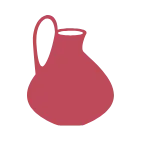
3,340
students online
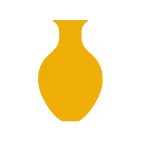
over 300
new ceramists: trained professionals

7,600
followers on Facebook and 6,300 on Instagram

319,000
views on Youtube